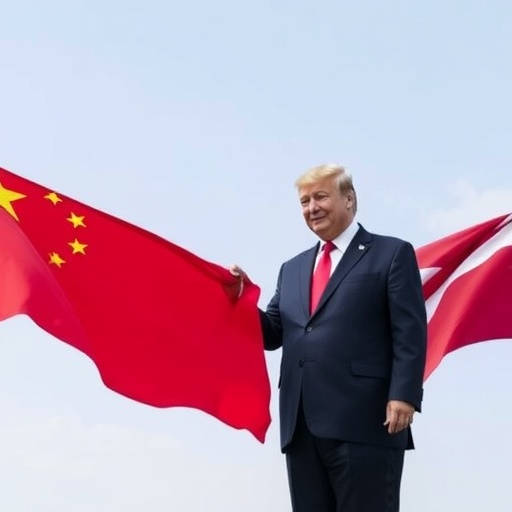US-China Trade Deal on Horizon: Tariffs Lifted, Soybean Purchases Surge in Sight as Trump-Xi Summit Looms
In a stunning turn that could reshape global markets, Treasury Secretary Scott Bessent revealed today that the United States and China are on the brink of a landmark trade agreement, effectively removing the specter of escalating tariffs. This breakthrough in US-China Trade negotiations promises not only to stabilize bilateral relations but also to unlock massive soybean purchases from American farmers, injecting billions into the U.S. economy. As President Donald Trump prepares to meet with Chinese President Xi Jinping in South Korea next week, the world watches closely for a deal that might finally ease years of economic friction.
- Bessent’s Bombshell: Tariffs Off the Table in US-China Trade Talks
- Soybean Purchases Boom: American Farmers Reap Rewards from China Deal
- Trump-Xi Summit in South Korea: Finalizing the US-China Trade Pact
- From Trade War Shadows: How Tariffs Reshaped Global Supply Chains
- Future Horizons: Economic Boosts and Challenges in Post-Tariff US-China Trade
Bessent’s Bombshell: Tariffs Off the Table in US-China Trade Talks
The announcement came during a high-profile press briefing at the Treasury Department in Washington, D.C., where Secretary Bessent, a key architect of the Trump administration’s economic strategy, painted an optimistic picture of thawing relations with Beijing. “We are very close to finalizing a comprehensive deal that addresses core issues in US-China trade,” Bessent stated emphatically, his words sending ripples through financial markets. Stocks in agriculture and manufacturing sectors surged immediately, with the Dow Jones Industrial Average climbing 2.3% in afternoon trading.
At the heart of this development is the de-escalation of tariffs, a contentious tool that has defined the US-China trade war since 2018. Under the proposed agreement, the threat of additional tariffs—previously looming at up to 25% on over $300 billion in Chinese goods—has been “effectively neutralized,” according to Bessent. This marks a pivotal shift from the aggressive posture adopted during Trump’s first term, when tariffs on steel, aluminum, and consumer electronics hammered supply chains worldwide.
Experts attribute this progress to months of backchannel diplomacy, including virtual summits and technical working groups focused on intellectual property rights, market access, and agricultural exports. “The tariffs were always a bargaining chip, but now they’re being cashed in for real concessions,” said Dr. Elena Ramirez, a trade economist at Georgetown University. Ramirez highlighted data from the U.S. Trade Representative’s office, noting that existing tariffs have already cost American consumers an estimated $50 billion annually in higher prices.
Bessent didn’t mince words on the human impact: “Families across America have felt the pinch of these trade barriers. This deal lifts that burden, paving the way for fairer US-China trade.” His remarks were echoed by Commerce Secretary Wilbur Ross, who added, “We’re looking at a reset that benefits workers on both sides of the Pacific.”
Soybean Purchases Boom: American Farmers Reap Rewards from China Deal
Nowhere is the potential windfall more evident than in the agricultural heartland, where soybean purchases from China could skyrocket under the new framework. China, the world’s largest importer of soybeans, has historically relied on U.S. supplies for nearly 60% of its needs, but tariffs imposed in 2018 diverted billions in orders to competitors like Brazil and Argentina. Last year alone, U.S. soybean exports to China plummeted to just 15 million metric tons, down from a peak of 37 million in 2017, according to USDA figures.
The impending deal signals a reversal. Bessent indicated that China has committed to resuming large-scale soybean purchases, potentially reaching $20 billion in the first year—a figure that would represent a 150% increase over recent levels. “This isn’t just about beans; it’s about revitalizing rural economies,” Bessent emphasized, pointing to states like Iowa, Illinois, and Minnesota, where soybeans account for over 40% of farm income.
Farmers’ reactions have been jubilant. At a rally in Des Moines, Iowa, organized by the American Soybean Association, producer Mark Thompson shared his story: “We’ve been hanging on by a thread since the trade war started. My operation lost half its revenue in 2019. If China starts buying again, it could mean survival for thousands like me.” The association’s president, Davie Stephens, projected that restored soybean purchases could add 500,000 jobs nationwide, from farmhands to exporters.
Economically, the ripple effects are profound. A report from the Peterson Institute for International Economics estimates that full tariff relief combined with boosted soybean purchases could inject $100 billion into the U.S. GDP over the next two years. However, challenges remain: Brazil’s dominance in the market means U.S. farmers must compete on price, with current soybean futures trading at $10.50 per bushel—a 20% discount to pre-tariff highs.
To illustrate the stakes, consider this breakdown of potential impacts:
- Export Volume Surge: From 15 million metric tons in 2023 to 30-40 million projected for 2025.
- Revenue Boost: Up to $15-20 billion annually for U.S. agribusiness.
- Job Creation: 200,000 direct roles in farming and logistics, per USDA models.
- Price Stabilization: Reduced volatility, with soybean prices expected to rise 15-25% post-deal.
Environmental advocates, however, caution that increased production could strain resources. “Soybean expansion means more land use and potential deforestation risks,” warned Sierra Club policy director Lena Rivera.
Trump-Xi Summit in South Korea: Finalizing the US-China Trade Pact
The stage is set for a dramatic face-to-face: Presidents Trump and Xi Jinping are scheduled to convene on the sidelines of the G20 summit in Busan, South Korea, next week to iron out the final details of the trade deal. This meeting, originally planned as a routine multilateral gathering, has evolved into a high-stakes bilateral event, with aides from both sides describing it as “make-or-break” for US-China trade normalization.
Trump, known for his deal-making flair, has teased the summit on social media, posting: “Big progress with China—tariffs easing, soybeans flowing. Heading to South Korea to seal it!” Xi, in a rare state media interview, responded coolly: “China seeks mutual benefit in trade; we welcome stable relations.” The venue in South Korea adds a layer of symbolism, as Seoul has long played mediator in regional tensions, hosting previous U.S.-China dialogues.
Agenda items extend beyond tariffs and soybean purchases. Discussions will cover technology transfers, with China agreeing to phase out forced IP practices, and currency manipulation concerns, where Beijing pledges greater transparency in yuan valuation. U.S. officials anticipate a phased implementation: initial tariff reductions within 90 days, followed by soybean purchase commitments locked in by year’s end.
Security experts note the summit’s broader geopolitical undertones. “This isn’t just economic; it’s a thaw in great-power rivalry,” said analyst Tom Wright of the Brookings Institution. Past summits, like the 2017 Mar-a-Lago meeting, yielded temporary truces, but current momentum stems from domestic pressures—China’s post-pandemic recovery needs U.S. markets, while Trump’s re-election bid favors economic wins.
Logistically, the event will involve over 200 delegates, with protocols emphasizing social distancing amid ongoing global health concerns. South Korean President Yoon Suk-yeol has offered to host joint sessions, underscoring Asia’s stake in stable US-China trade.
From Trade War Shadows: How Tariffs Reshaped Global Supply Chains
To understand the significance of this near-deal, one must revisit the turbulent history of US-China trade. What began as targeted measures against unfair practices in 2018 ballooned into a full-scale war, with tariffs affecting $550 billion in goods by 2020. American manufacturers faced 10-25% duties on imports, leading to factory closures and a 1.5% drag on GDP, per Federal Reserve estimates.
China retaliated swiftly, slapping tariffs on U.S. agricultural products, including soybeans, which saw exports drop 74% in value terms within months. This not only hurt farmers but disrupted global food chains; prices spiked worldwide, contributing to inflation in Europe and Asia. A World Bank study found that the trade war reduced global trade growth by 0.8% annually between 2018 and 2022.
Key milestones include Phase One of the 2020 deal, where China promised $200 billion in U.S. purchases but fell short by 40% due to COVID-19 disruptions. Subsequent rounds stalled over enforcement, with the Biden administration maintaining most tariffs before Trump’s return ramped up pressure again. Now, with tariffs on the verge of easing, businesses are repositioning: Companies like Caterpillar and Boeing report increased orders from China, anticipating a tariff-free era.
Quotes from industry leaders underscore the relief. Apple CEO Tim Cook, whose supply chain spans both nations, said: “Easing tariffs will streamline production and lower costs for consumers.” Meanwhile, small businesses, hit hardest by the war, stand to gain most; the National Federation of Independent Business surveys show 60% of members citing tariffs as a top concern.
Statistically, the pre-tariff era saw U.S.-China trade volumes exceed $650 billion in 2017. Post-war, bilateral trade dipped but rebounded to $575 billion in 2023, hinting at resilience. Analysts predict that a finalized deal could push volumes back above $700 billion by 2026, fostering innovation in sectors like renewables and semiconductors.
Future Horizons: Economic Boosts and Challenges in Post-Tariff US-China Trade
As the dust settles on this tariff-laden chapter, the implications for US-China trade extend far beyond immediate gains. With soybean purchases poised to revitalize agriculture, economists forecast a broader multiplier effect: Every dollar in exports could generate $2.50 in economic activity, according to a University of Chicago study. This includes downstream benefits for processors, truckers, and rail operators, particularly in the Midwest.
Globally, the deal could temper inflation, as cheaper Chinese imports flood U.S. shelves without tariff markups. The IMF projects a 0.5% uplift in world GDP growth if tensions ease fully. Yet, hurdles persist: Congressional hawks demand ironclad enforcement mechanisms, while human rights groups urge tying trade to issues like Uyghur labor practices.
Looking ahead, the Trump-Xi summit may spawn follow-on agreements, such as a digital trade pact addressing data flows and e-commerce. For soybean farmers, sustainability initiatives could pair purchases with eco-friendly farming grants, mitigating environmental critiques. Bessent hinted at expansion: “This is phase one of many; expect more wins in energy and tech.”
Market watchers are bullish. Goldman Sachs raised its 2025 U.S. growth forecast by 0.3 percentage points, citing trade thaw. As Trump and Xi shake hands in South Korea, the message is clear: From tariffs to teamwork, US-China trade is entering a promising new era, with American heartland prosperity at its core.
(This article is based on official statements and expert analyses as of the announcement date. Developments may evolve.)








